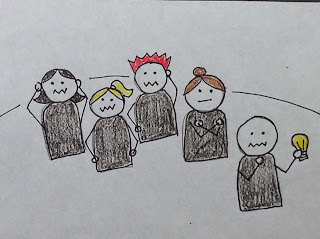How Many Sign Language Interpreters Does It Take....
... to screw in a light bulb? (Or, 'How to Explain Interpreting for the Theatre or Concerts in a Nutshell').
 |
| Image Description: Stick figures of five interpreters. One holds up a light bulb while four others look on in puzzlement. |
Why a light bulb analogy?
Utilizing real-world connections, an interpreter is given a task – that of interpreting a touring Broadway performance in a given city. Before accepting the gig, they might consider the factors that would be involved. What type of light bulb is used might parallel that of what type of show is it? (A musical production, maybe a Rodgers and Hammerstein or an Andrew Lloyd Webber production). What types of interpreting approaches should not be used? (In this case, the gig calls for a team interpreter and avoid the academic interpreting style of taking turns being on the hot seat to interpret for fifteen to twenty minutes stretches, and so on).
As for asking if this is a rush job, the current practice in the field is to request for interpreters with at least two weeks’ notice. With more time allocated to preparing for the performance, the interpreter will be well prepared. Less, and the interpreter faces issues with quality of the interpretation provided. Where the light bulb; (or in this case, the gig) is located is also another factor to consider. Is it worth it to drive three hours for a theater interpreting gig, or should one consider gigs within one’s hometown?
The last factor – whether or not there is material for the interpreter to prepare – is the largest impact on the quality of the interpreter’s performance. While replacing a light bulb might seem straightforward, preparing to interpret for a musical is not always so straightforward. In terms of material, the interpreter might have access to a script or a libretto, and audio and/or video recordings of the production. In an ideal world, the interpreter would have access to all and could thus pull off the entire task at hand. Without preparation to form the foundation of the process, the interpreter in question might not be able to screw in the light bulb.
Now, let’s not forget the four colleagues in the room watching the singular interpreter replace the light bulb in the spotlight. Why are there four, one might ask? While the action of screwing in the light bulb requires a single person, the other four are there observing the task and providing their own thoughts and insight. If the light bulb were to be removed and given to another colleague, they might have approached the process differently from the first interpreter.
There is no right or wrong answer to this task as presented by the light bulb analogy within the sign language interpreting community. Give five interpreters the same task, and five different results will be procured. How those five products differ is left up to the individual interpreter’s background, training, education, biases, just to name a few factors that might influence their performance.
Drawing a parallel between the light bulb analogy and the real world, consider the role and responsibilities of the theatre sign language interpreter. As venues and theaters try to cater to the requests of interpreted performances, one might consider the discrepancies in quality of the interpreted services rendered. This varies from location to location, from venue to venue, even from interpreter to interpreter. A team of three interpreters interpreting a performance of Wicked on Broadway might approach the show from an angle while teams of two interpreters each for each of the two national tours might take a difference stance to the same show. All seven interpreters are drawing their own interpretation of the musical using the same script, the same music, and the same lyrics.
The same light bulb.
Excerpt reprinted from "The Song That Goes Like This: The Art of Theatrical Sign Language Interpreting and Translating" which can be read in full at the University of Minnesota Digital Conservancy here
Source Link: http://conservancy.umn.edu/handle/11299/163479

Comments
Post a Comment
Please leave a name with your question, comment, or heartfelt concern.